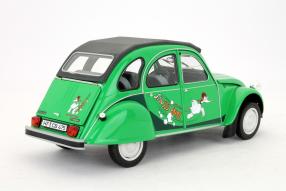Friends of "the duck" - the legendary Citroën 2CV - have marked the period between July 28th to August 2nd 2015 in their calendar for month: The organizers of the 21st International 2CV meeting expect that this year's event in Torun / Poland will attract more than 7,000 cars and 20,000 participants. For a whole week the city in Poland will celebrate the popular and unforgotten small Citroën, whose production ended exactly 25 years ago. The Citroën 2CV - in Germany primarily known as "the duck"- was first presented in October 1948 at the Paris Motor Show. Smiled at from the press at first , the Citroën 2CV was to become one of the most famous and best-selling models of the brand Citroën. The duck scored with their appearance, but also with their special characteristics.
Foldable roof gave the duck convertible qualities
The vehicle astonished with its refined design, the versatile utility and extreme efficiency. With the foldable roof the 2CV also caused a lot of fun; there was probably never a more favorable convertible on the market. On July 27th, 1990 - ie exactly 25 years ago - the last duck ran off the production line in the factory in Mangualde in Portugal . Between 1949 and 1990 a total of 3,868,631 sedans and 1,246,335 vans called "Kastenente" were built. Currently there are still around 12,000 registered 2CV in Germany; the duck is becoming more and more of a collector's item. That was and is Deux Chevaux in the format of the model car: Many manufacturers have tried the downsizing of the duck: Meanwhile, and technical advances in model accordingly with great success.
.
Sausss- duck from Norev in 1:18 scale
As one of the most beautiful miniatures for 2CV available under the article number 181513 and limited to 600 copies Sausss duck from Norev brings many other features in addition to its colorful decoration. So the model made of zinc die-cast inscale of 1:18 feautures a detail-equipped engine room, an authentic interior equipment, working steering and a opening bonnet, functioning front doors and an openable trunk lid. The prototype for this model car appeared in 1987. The approximately 27 centimeters long and 850 grams heavy car model consists of approximately 100 individual parts. The observer noticed immediately the proper style sticker on the side and the rear lid of the model car. The inscription "From 0 to 100 in 59.4 s" and the cool duck with pilot hood nominate the vehicle to Sausss duck
Thoroughly elaborated details in the engine compartment
Furthermore, the model is a typical representative of the Norev line: Expertly crafted and absolutely in accordance with the look of the model in its appearance. Radiator fan and air filter, battery and aggregates around the small motor are reproduced exactly. The grille was pierced by the creators of Vaulx-en-Vaulin, so authentic see through. The chromed headlight and the round indicators sit perfectly on the free-standing fenders. They correspond in shape and design as those of the duck just like the tail lights in orange and red. At the rear, the thin end tip of the separately mounted exhaust system peeks out. The gutters are painted silver; Door handles and bonnet in the rear are chrome. A rare detail is the the bicolored wiper.
Prototypically simulated interior
The foldable roof is shown in gray plastic and stays closed. But Norev attached a second roof , with which the collector may put convertible feeling on the model. The rubber tires are mounted on lacquered disc wheels and have a prototypical profile. Two-tone gray and black the buyer finds the front and rear bumpers . In silver : the fuel tank cap on the right rear fender. The dashboard and the steering wheel with the contemporary thin rim are executed spartan black.
A good sense of how soft the duck speeders have immersed in the pews of the car, also conveys the authentic styled seats. Our conclusion: For 49.95 euros a great model car that keeps the fresh feeling of the 2CV alive. There are more miniatures to the duck : we have put together a list for you, dear readers, in the recommendations below. There are so many, with quite different colors and structures that we could almost make a private duck meetings ourselves.












 [28.07.2015] Hot off the press: Model car of Sebastian Vettel's Ferrari SF15-T
[28.07.2015] Hot off the press: Model car of Sebastian Vettel's Ferrari SF15-T [24.07.2015] BREAKING NEWS: New BMW, Ford and Porsche in scale 1:18 by Minichamps
[24.07.2015] BREAKING NEWS: New BMW, Ford and Porsche in scale 1:18 by Minichamps

